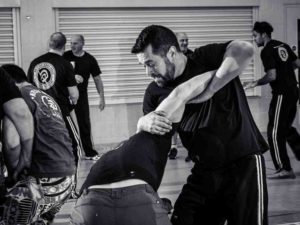Control and Restraint in Self Defence
I was recently asked to provide some training in the form of holding techniques to a security professional interested in Control and Restraint in Self Defence. This was my reply, I thought I would share it on the blog as it may contain some useful and relevant information to students of Krav Maga, martial arts and other forms of self defence as well as security professionals.
Personally I know a lot of holding techniques but the problem is getting them to work. If we train them in an TMA (traditional martial arts) sense then we can pretty much make anything work, getting them to work in real life is another thing altogether. The police have more success at times but they have the uniform as a big advantage and lots of backup things go wrong.
Dependant on the situation there are a lot of possible responses – it all varies how much they are kicking off or complying as well as the level of threat. The more training you have in case it does kick off and you have to go to self defence mode the better. Law enforcement officers (LEOs) go hands on more than most people and the LAPD in recent years have provided us with a good credible source of info of course bearing in mind that from a SD perspective we are looking for different results (to survive) there is still some insightful crossover into SD but also very useful info for the front line professional.
Myth: 90% of attacks go to the ground
From a LEO viewpoint, they are in a position where the offender has to be controlled/arrested so often many of these situations do go to the ground (but significantly less than suggested). During 1988, there were 316,525 arrests made by LAPD.
• 5,617 (1.7%) of these arrests required the completion of a use of force report.
• 2,031 (0.6%) altercations developed from these arrests. “Of the 5,617 reports examined, only 2,031 incidents contained a sufficient level of aggressive resistance by the suspect toward the officer to qualify as an altercation.”
Thus, the study confirms what every police officer knows: most arrest situations involve little or no use of force, and minor resistance does not qualify as a “fight” (or in this case, altercation). Control and Restraint in Self Defence does at times apply given that you may need to restrain someone until. for example, Police arrive.
LAPD found that there were 5 scenario patterns from an altercation. Four combative actions by suspects accounted for almost two thirds (65.8%) of these I.O.D. injuries; the officer was kicked 23.4 percent, punched 16 percent, thrown/tripped 15 percent, or was bitten 11.4 percent.
Kicking resulted in injuries to the legs (36%), the head (27%), the rib cage (22.5%), and the groin (14%). Although several fractures occurred, the most common injury was a bruise to the legs, head, ribs, or groin. The most common injury suffered in ground fighting was a strained lower back.
“Nearly two thirds of the 1988 altercations (62%) ended with the officer and subject on the ground with the officer applying a joint lock and handcuffing the subject.” **As mentioned previously this is 62% of fights going to the ground – but it is 60% of the 1.7% of the fights that qualified as an altercation. Bear in mind that from a SD(self defence) perspective the best form of restraint is unconsciousness as opposed to handcuffing – something we legally cannot do in the UK as civilians. In Krav Maga we look to deal with the threat and retreat to safety (similarly as do Close Protection) but LEO and DS (Door Supervisors) etc need to restrain as they are unable to leg it to safety.
Controlling an aggressive attacker in real life in a one on one situation without hurting them is extremely difficult and you would certainly need a significant strength advantage. Also from a SD perspective, if you are on the High Street and end up restraining someone, bear in mind you may have a 20 minute wait for Police to turn up to help you. That is a long time to hold someone down. Possible in a team but on your own this is very hard and poses a lot of potential risks.
One thing that is proven though is the more training you have the more confident you will be and the less likely it is to kick off, also there is significant lesser chance of injury and faster recovery.

Leave a Reply
Want to join the discussion?Feel free to contribute!